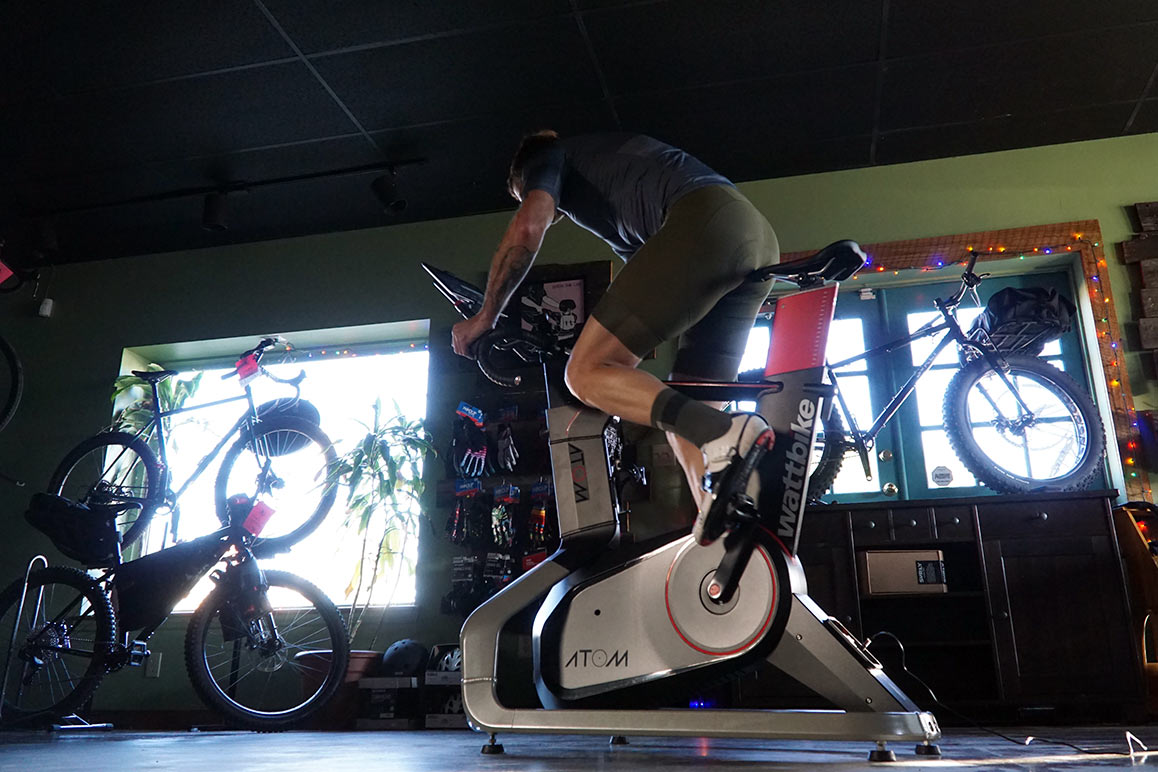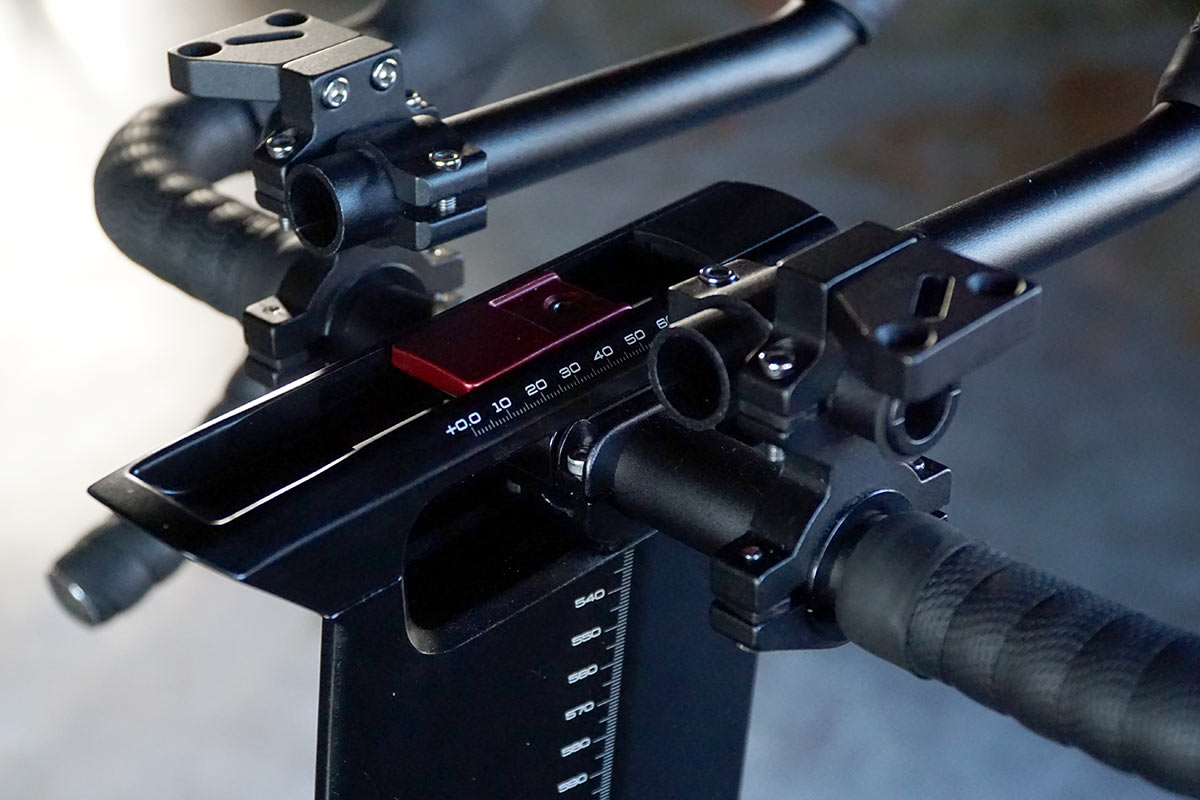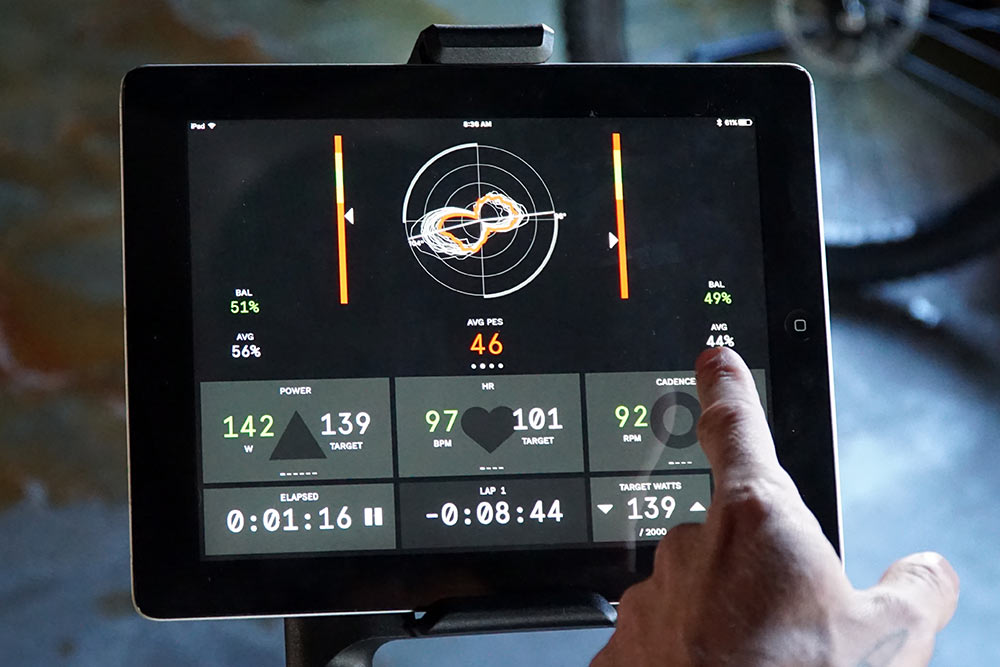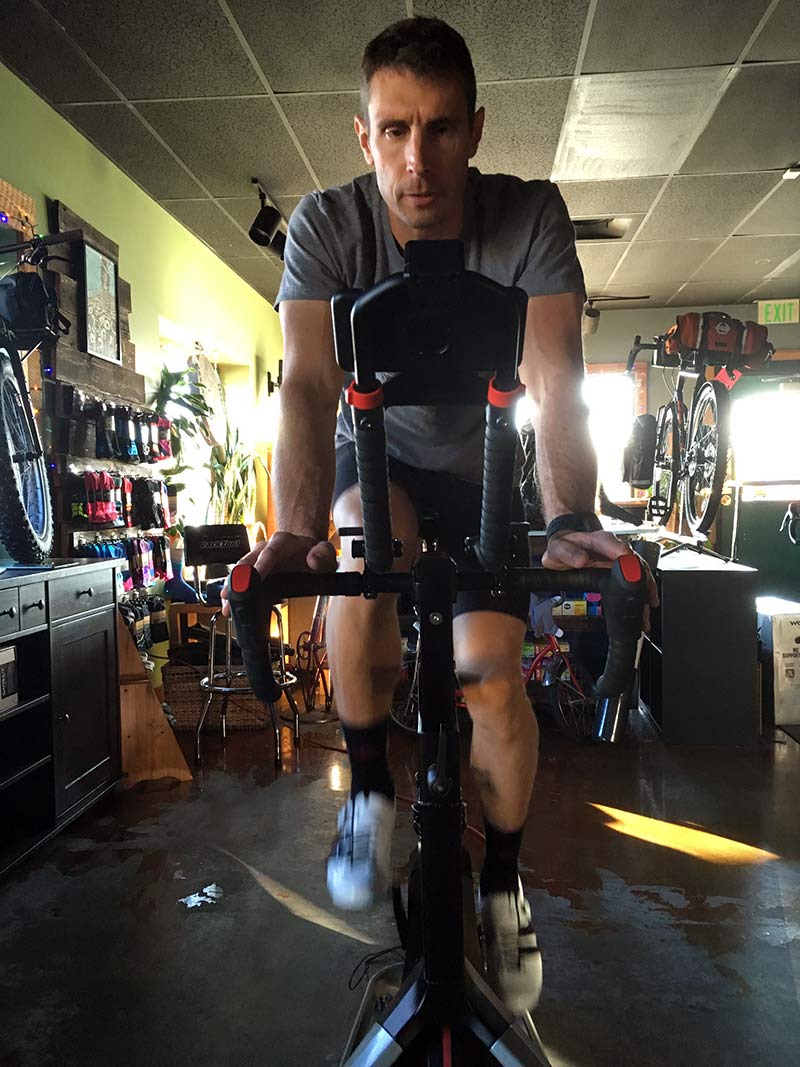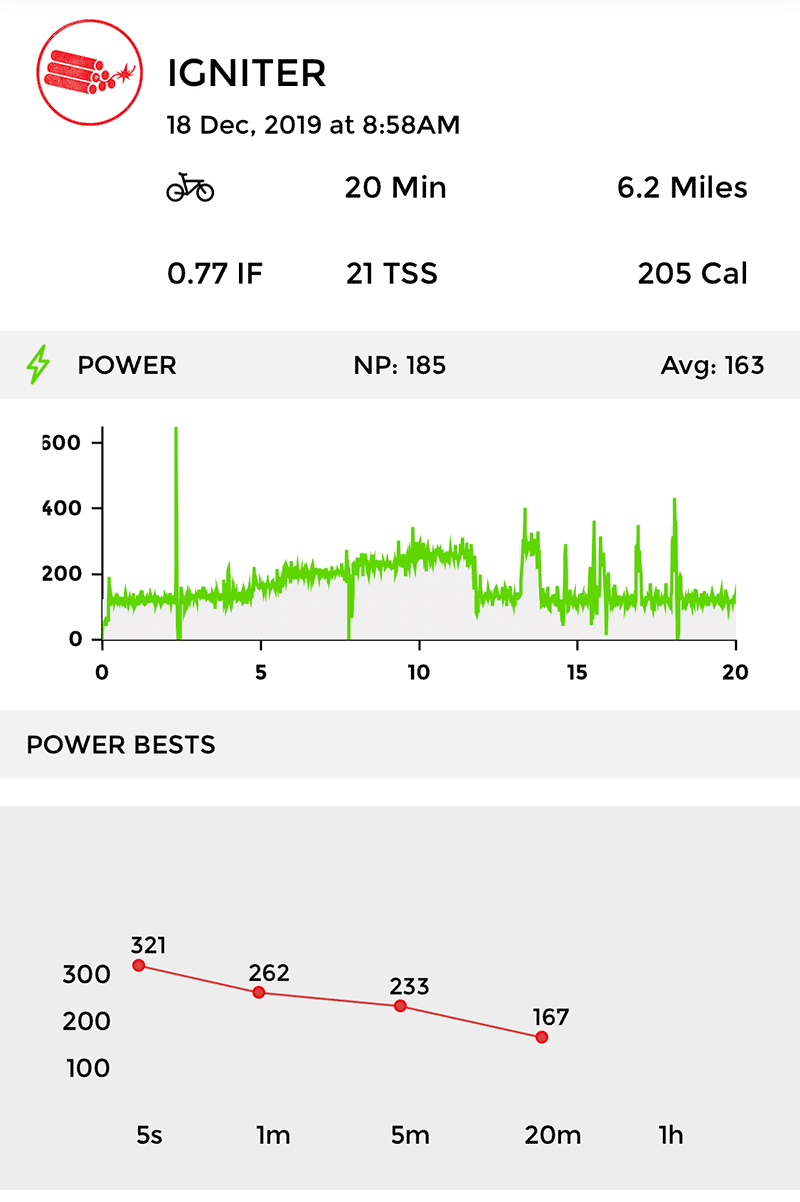Like most of you, I’ve watched the phenomenon of the committed indoor-bike with more than a little head-scratching. They’re everywhere. In Hulu commercials. Sponsored Facebook ads. Outdoor magazines. Even my deceased grandmother knows what a Peloton is. It’s like we all suddenly woke up in some alternate dimension: One where the sport of cycling is completely mainstream, but totally different from the cycling we grew up with and know. One where the two big industry pushes are for riding pedal assist E-bikes outdoors… And working really hard to pedal in place indoors.
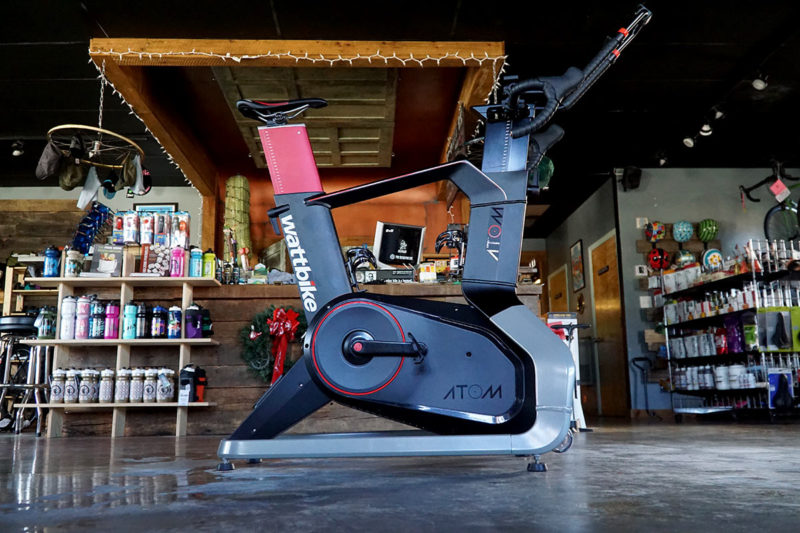
And let me make a confession: I’m actually OK with riding an indoor trainer. Legitimately OK with it.
So much so that there are days perfectly suited for riding outside on which I willingly make the decision to ride the trainer instead. It’s a complicated crossroads of time, place, and headspace.
Time: The simple fact is that I used to have it, and for reasons, these days I don’t. No. I don’t like that either.
Place: Say what you will, but you’ll never convince me that the central southeast is anything but an abyss of suburban congestion and provincial politics. One giant sprawling suburb of Charlotte, NC, with different names. And the once bucolic ribbons of relatively quiet tarmac I used to ride are now busy thoroughfares choked with homogeneous white-flight developments full of angry, entitled, distracted drivers.
Headspace: See above. But also… There are simply days that I feel more motivated to take a staple gun to my cheek than to get out on the same stretches of trail or road that I’ve been riding for the past 18 years. In case you were wondering, my suburban ennui is at defcon-0.
So… to trick myself out of depressive torpor and into some semblance of action, I sometimes opt for a Sisyphean middle ground. A relatively short indoor trainer workout so hard that I feel like puking…all the while distracting myself with documentaries and British murder mysteries.
(At the moment I’m three episodes into Fortitude, a crime drama set in the Arctic (with, incidentally, a considerable amount of full frontal nudity).)
And the fact is that this bizarre ritual of tethered riding… is currently more interesting to me than riding the same stretches of road past the same lawns past the same houses.
No. I’m not saying that’s a healthy place to be in my relationship with the bike. I’m just… saying.
So yeah, I ride the trainer. More than I would like.
Let’s get (committed) to it!
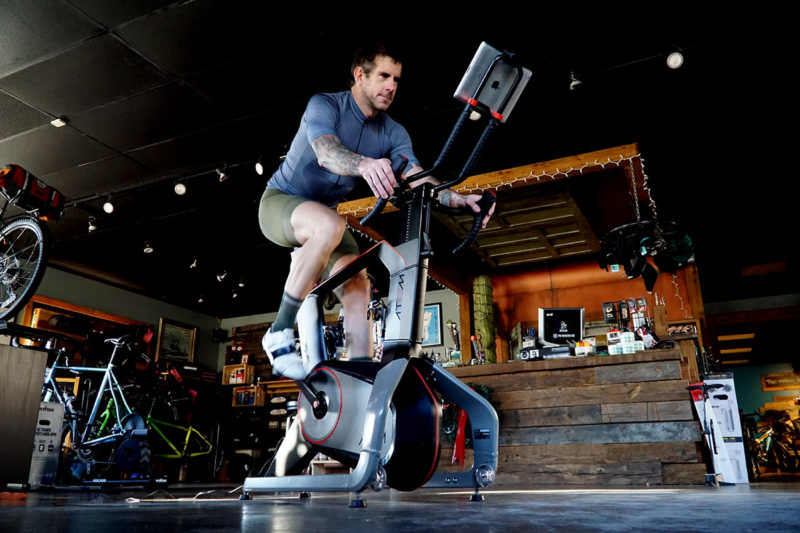
I will concede that a committed indoor-bicycle with no other possible application takes this all to a whole new level. So let’s check it out.
From what I found in my exhaustive research (ummm…), the Wattbike Atom seems to bridge a gap. It’s user friendly in ways that make it extremely accessible to non-cyclists looking for a way to workout at home. And it has a wealth of features, adjustability, and connectivity for advanced cyclists interested in a committed training machine on which they can log structured workouts.
Wattbike Atom setup
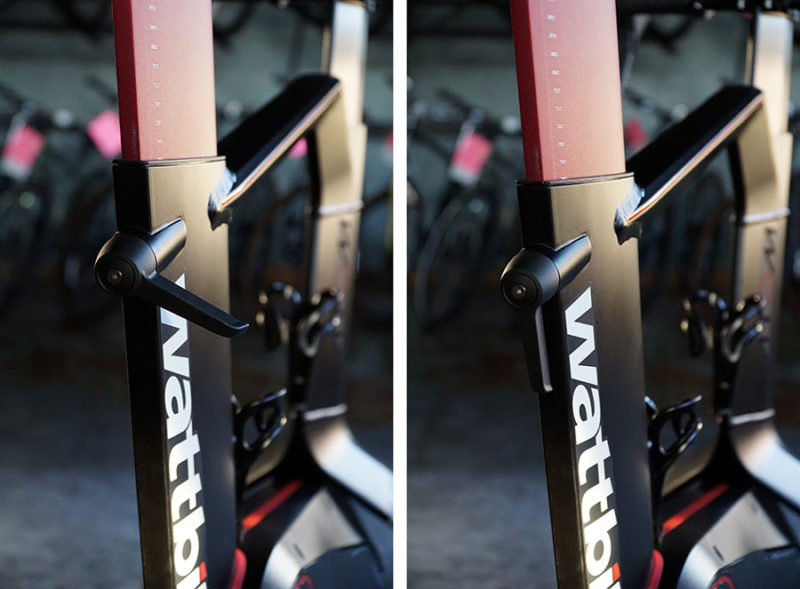
Straight out of the box, the Wattbike Atom was easy to set up. Just a matter of loosening and tightening some levers, and turning a few (provided) Allen keys. It probably took me 10 minutes, which included swapping pedals off another bike, pulling a few measurements, and dialing in the fit. Saddle position, reach, and handlebar drop are all easy to adjust. It’s even the kind of easy that would potentially allow for multiple riders to use the Wattbike in relatively quick succession, assuming they had some fit numbers memorized or readily available. Lower the seat. Move the “stem.” And voila.
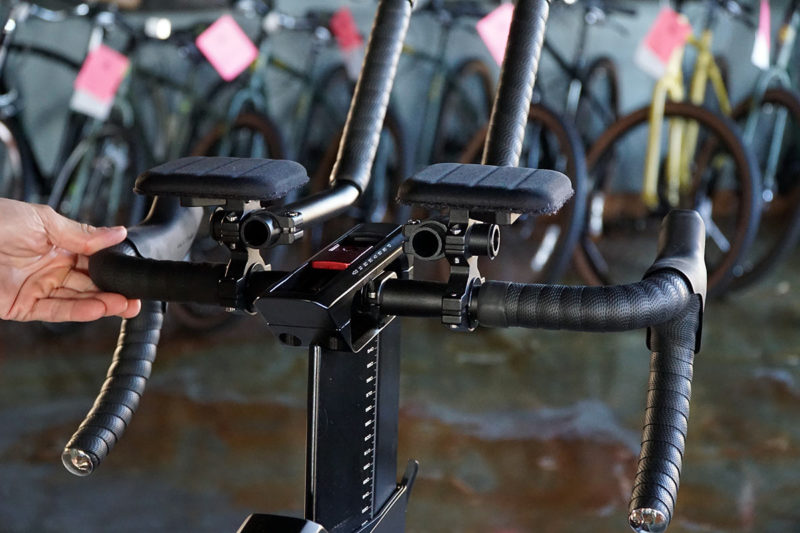
My one gripe regarding adjustability might be that the position of the hoods on the handlebar was lower than I would prefer, and accessing the bolts to rotate the handlebar wasn’t particularly easy. Though ideally, I’d like to adjust their position on the handlebar itself, which would involve unwrapping and rewrapping the bar tape. And that’s all certainly doable, but not within the time restraints of a review item that has to be returned.
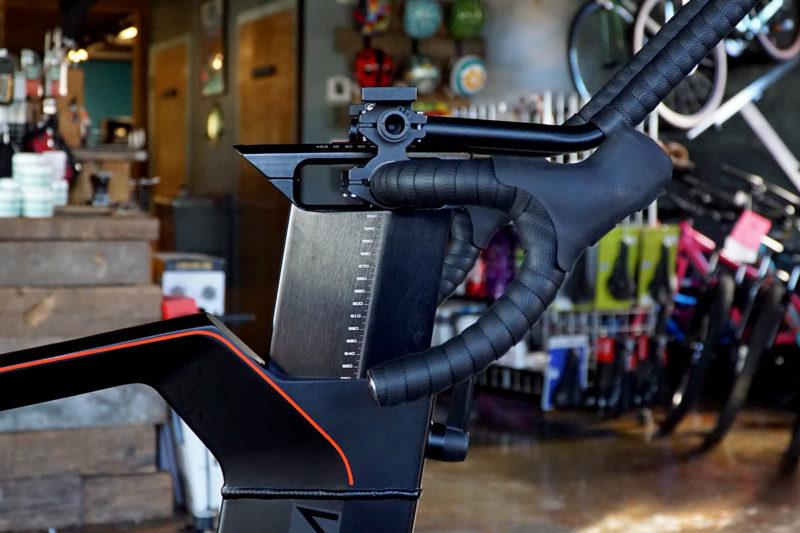
It also came stock with an aerobar that doubled as a support for iPhones, iPads, and tablets. A legitimately nice feature that keeps your technology in reach, but away from your corrosive sweat. I didn’t use the arm rests, which is why you don’t see them in most of the photos. The mounts could be swapped left-to-right, too, such that they’d encroach on your hand space less, but, again, review unit, so I left them as-is.

The only two fit metrics that are non-adjustable are Q factor and crank length. 160 and 170, respectively. Regarding the former, I’m constantly changing from bike to bike and discipline to discipline, and every one of my bikes has a different Q-Factor. And while shorter than I typically run, I can see no way in which the 170mm crank length would adversely affect any kind of training I would do on the Wattbike. If anything it probably makes me spin a little more?
Controlling it all with the Wattbike App
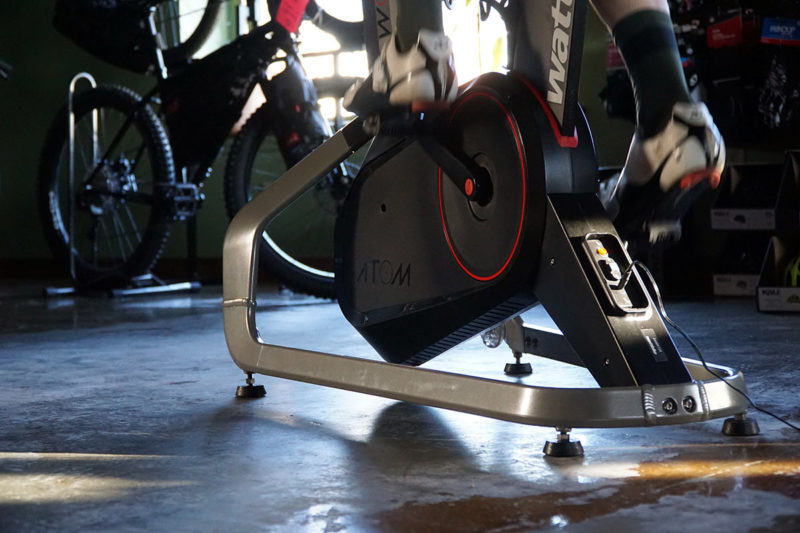
I’m not ashamed to admit that I am not technologically savvy. At all. (Case in point: my total inability to digitally sign and return the “lease agreement” that Wattbike has emailed me multiple times. I’m working on it, y’all.) So I was expecting to be stonewalled at multiple turns by either device incompatibilities or some baffling web of mandatory updates and downloads. And yet, setting up and utilizing the Wattbike app and platform was refreshingly easy, even with my sorely outdated iPad. Once I had downloaded the free app and created a profile, I was instantly ready to start riding.
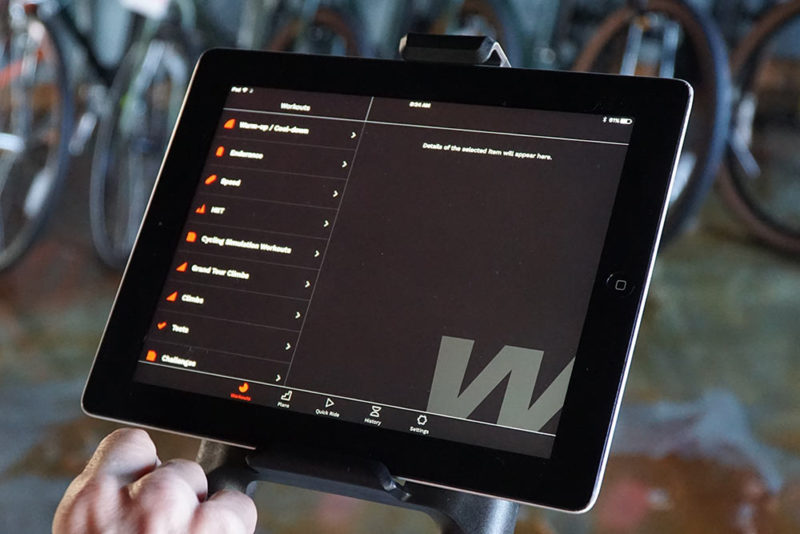
The app has a multitude of workouts, fitness tests, and training plans immediately accessible. And while not as in depth as Trainer Road or Sufferfest, and while the language is decidedly Euro, (with such names as “Haute Route,” “Sportive,” and “Rugby Training”) I’d wager that even the most veteran of cyclists could utilize any one of the available plans and workouts and make decided strides in fitness.
Because I refuse to read directions, it took me a warm up or two to figure out how the Wattbike controls worked. Once I did, switching between screens, and even between the ERGO and Gear modes was simple. ERGO mode, by the way, is “smart.” Resistance increases according to the metrics of the ride. If you’re supposed to hit 320 watts for an interval period, it won’t matter whether you spin or mash, you will be forced to hit 320 watts.

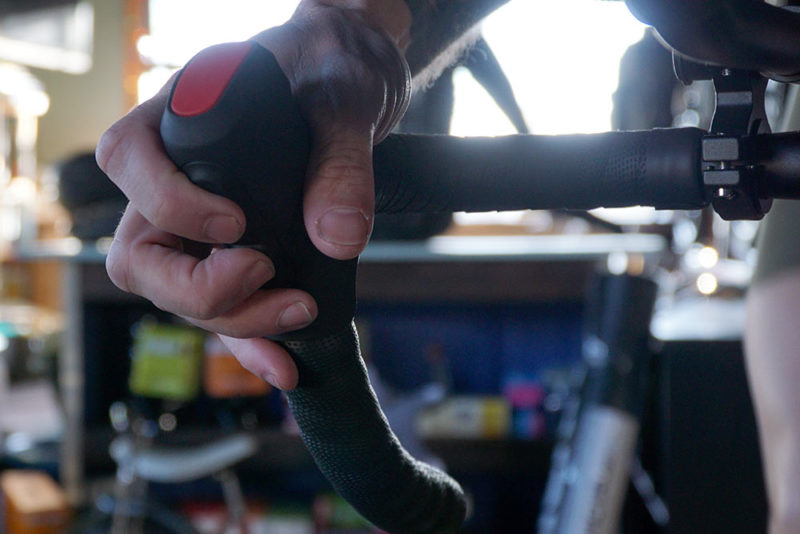
In “Gear Mode,” you toggle through a range of 22 virtual gears with buttons located on the underside of the right-hand shifter.
I found the jump between gears to be relatively large in comparison to the watt increases of the workouts. Meaning that if I was trying to peg 320 watts, I would find myself in the awkward position of spinning at either 113 rpm in “gear 6” or 85rpm in “gear 7″… and always overshooting or undershooting the prescribed wattage at my preferred cadence of 100-105rpm. Additionally, in ERGO mode, the lag in timed resistance was great enough that during intervals less than 30 seconds, I would barely reach my goal watts before it was over and time to recover. Their own comparison chart between the current Wattbike models (the Atom and the Pro/Trainer), the suitability for high intensity interval training (HIIT) is even marked as “so so”:

(And yes… it’s a little weird to keep saying “watts.”)
The logical thing seems to be to utilize ERGO mode for sweet spot and sustained power rides, where interval periods are longer, and to use Gear mode for shorter high intensity intervals (HIIT).
This was a minor issue, and easy enough to navigate in the Wattbike app. Except…
While the Atom instantly synced with third party apps like Trainer Road and Sufferfest, I couldn’t seem to access gear mode when using them. It automatically defaulted to ERGO mode. I’m told that overall that this should not be the case, and that gear mode is accessible in most third party platforms, but that a few Trainer Road fitness tests will automatically use ERGO mode. Which is the program I was primarily using, so that makes sense. I’ll update with any findings. And you can read Tyler’s experience further down.

By far the most interesting feature of the Wattbike Atom to me was the leg balance. During the workouts, you can use the left hand “shifter” to toggle through a series of screens that show current interval position, average interval power, heart rate, etc…. and leg balance.
It took a little while to figure out exactly what I was looking at, and even then I imagine there’s a lot more info to be gleaned, but suffice to say it became glaringly obvious very quickly that I was WAY OFF on which of my legs is dominant. Throughout every workout, my right leg consistently produced 5% less power through each pedal stroke than my left. Additionally, it also highlighted the “dead spot” in each pedal stroke and at what cadences my pedaling efficiency was greatest.

I don’t typically pay any attention to metrics. The only reason I even know my FTP is a profound sense of existential boredom. And paying attention to my heart-rate? Meaningless. Because I’m still going to burn all those matches, whether it’s a good idea or not. But I could completely see putting myself into a deep, deep trance with this leg balance feature. Even if only to try and make different shapes with the digital readout… whether that translated into good things or bad things.
The app also has other screens you can watch, but those basically just present the same data that’s on the bottom half of the screen as charts and graphs.
Overall impression?
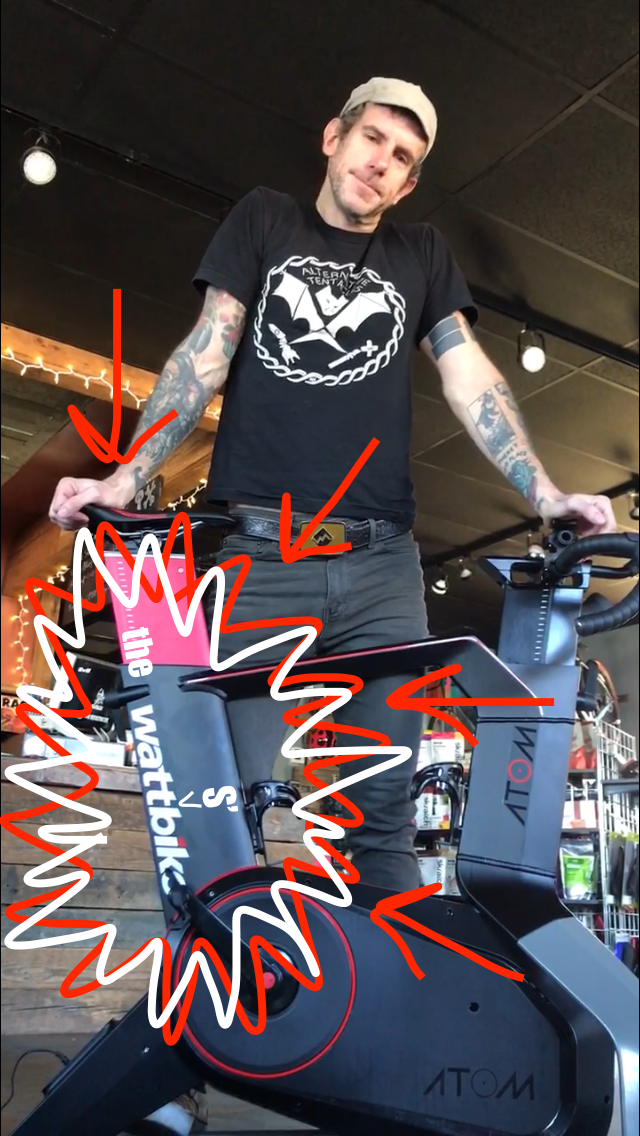
I enjoyed messing around with the Atom. And yeah… If I was in the market for a committed indoor bike, it would be at the top of the list. I mean. It has my name in it.
A few bullet points.
The Positives:
-It looks like something from TRON, and I don’t care what you say, TRON is great.
-It’s relatively quiet. There’s a distinctive “whir whir whir” as you pedal, to be sure, but it’s not enough to overwhelm the quiet, brogued dialogue of whatever understated British mystery series you happen to be watching. And while there are wheel-off trainers currently on the market that are a little quieter, the clapped out drive-train of the bike I’m riding on those trainers is not. So…
-Rollerblade wheels located on the front allow it to be easily moved in and out of corners, rooms, and maybe even down the half-mile stretch of road between your house and your bike shop. Though from experience, you will look absolutely insane when you do this.
-It’s user-friendly. Even as a moron, I had no issue utilizing the Wattbike platform or syncing it with various training apps. And while I didn’t get a chance to test Zwift specifically, since no screened device I own is currently compatible with it, yes, I have no doubt that the Atom interfaces seamlessly with it. Call it a hunch.
-It’s comfortable and super easy to adjust. Even the stock saddle gave me less issues than the saddle on my current road bike.
-At $2,599, it’s one of the more affordable and versatile indoor-bikes out there. The wealth of features, connectivity, and mechanics make it ideal for beginner to advanced riders currently interested in a committed indoor training bike. And unlike a Peloton and their ilk, there’s no subscription, upgrades or aftermarket things that would keep tapping my bank account (that’s what TrainingPeaks, The Sufferfest, Rouvy, Zwift, etc. are for…) So if you’ve been considering one, it’s a solid choice.
Potential Stumbling Blocks:
-The Promo-video for the Atom. It’s as if an AI watched a Rapha commercial on mute, then shouted at Alexa to google “gravel.” Just… watch it for yourself.
-The power cord. It’s a wee bit short? I don’t know if what was provided to me was a demo cord or what actually ships to customers, but at roughly four feet long, unless you have it set up right next to a wall with a really convenient power outlet, it wasn’t enough. Yes, easily solvable. But worth a mention?
-I have no idea what is going on inside of this thing. None. And while I can’t imagine that there’s a ton of maintenance to be done, and it has a 2 year warranty period, things used with any consistency tend to wear out in some way. And while I can track that and triage that on a traditional trainer: drivetrain, roller wear, etc… I wouldn’t even know where to start with the Atom.
-Ease of maneuverability aside, it still has a larger footprint than a wheel-on or wheel-off trainer. Which is a total non-issue if you have a committed space in your house or garage for this kind of thing. But if you live in an apartment, or, say, a two bedroom 1920’s bungalow where your 8′ x 8′ “dining room” doubles as the office/pantry/storage closet/plant reliquary/liquor cabinet/bike room… it might be a bit much?
-It’s $2,599. And while that’s relatively affordable in the skewed metrics of the bike industry, it’s still a hefty commitment. And, well… I turn my sink on with a screwdriver. So… yeah.

Which isn’t to say I won’t ask Wattbike if I can keep the Atom for a little while longer. (At least until winter is over and I’ve gotten this leg balance discrepancy thing figured out?)
And regarding the phenomenon of indoor bikes… As much as I would prefer that more people riding manifest itself as more cyclists out on the roads and trails… in its own roundabout way maybe it actually does translate into an increased interest in the sport. Oblique as it may be. And for people intimidated by the various physical and psychological impediments one has to overcome to ride a bike as an adult, it might even prove to be a starting point? Albeit it, an odd one.
One… can hope?
Tyler’s thoughts
Watts did the heavy lifting on this one, literally. He had to unbox and assemble the Wattbike Atom, which was apparently mostly assembled and quickly ready to ride. And he was easily able to move it back and forth between shop and home so we could take photos, so it is indeed pretty easy to move around. I showed up, took pictures of him, then opened my Sufferfest app on my iPhone. Within 10 seconds I had it connected to the Atom and Watt’s HR monitor (gross, I know) and started a short workout.
In Ergo mode, the Atom changed the resistance as the Sufferfest prescribed, and it did so very, very smoothly. So smoothly that I wondered if it was changing…and then all of a sudden I was sweating. A lot. The actual pedaling feel is very smooth, too, and unlike some smart trainers, when I coasted, it didn’t immediately put Sufferfest on pause.
As best we could tell, that smoothness happens because resistance changes are very gradual. That lack of urgency means 10 second intervals are pointless. Those green spikes on the back end of my workout? Never really felt the struggle. I imagine this is something Wattbike could improve with a firmware update, we’ve inquired and will report back. I also couldn’t switch away from Ergo mode, even when I unchecked that setting, so I couldn’t find a way to manually shift through gears while using Sufferfest (possibly short of just not connecting the trainer to the app, but then I wouldn’t be able to see speed/cadence/power data…it would all be perceived effort). Honestly, I don’t care about that, though, as Ergo mode and having the app control the resistance is the only way I actually get a real workout on a trainer.
Standing and hammering on this thing is rock solid. A little lower frame flex is visible, even under hard seated efforts, but it never felt flexy. The ease of adjustment and overall comfort is stellar. Easy syncing with your favorite app makes it even better.
Watts owns Revolution Cycles in Greensboro, NC. He writes regularly for Dirt Rag, is a frequent contributor to BikeRumor, and like everyone, used to have a blog or whatever. Maybe he’ll update it one day. Unfollow him on Instagram at @revoltingcogs.
